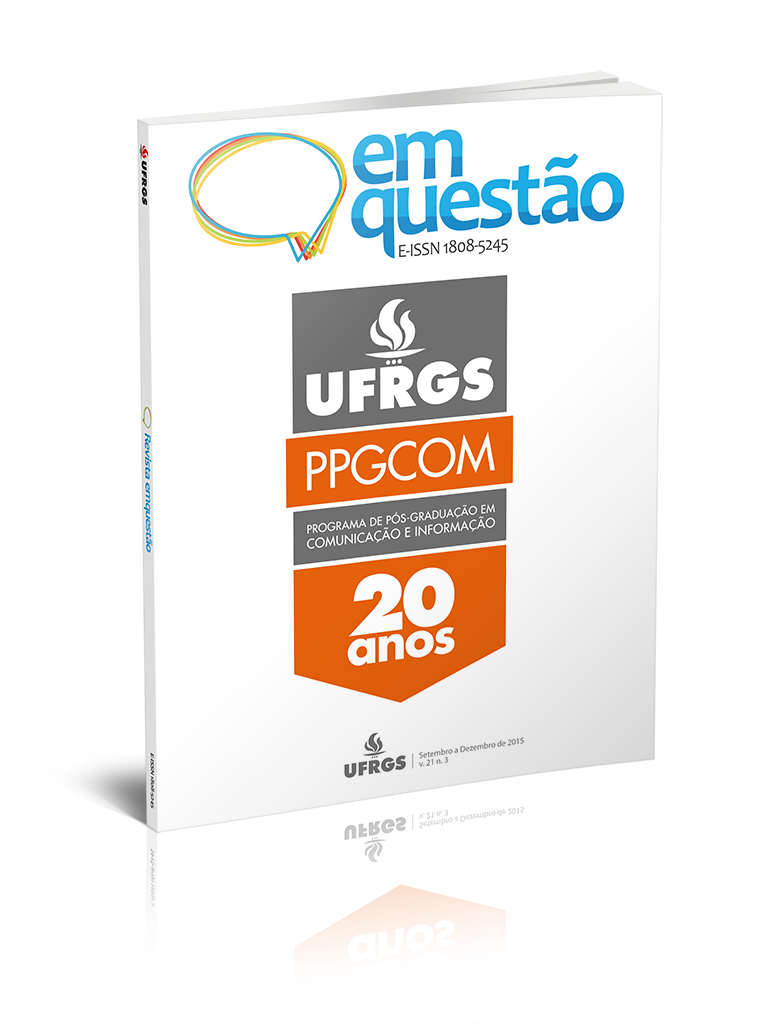O processo de circulação de informações sobre forró eletrônico e seu fluxo comunicacional em Fortaleza
DOI:
https://doi.org/10.19132/1808-5245213.171-189Palabras clave:
Forró Eletrônico. Circulação da Informação. Midiatização.Resumen
Com base em entrevistas com produtores e consumidores de forró eletrônico, este artigo reflete sobre o processo de circulação desse gênero musical em Fortaleza, capital do Ceará, aportando-se nos conceitos de “fluxo comunicacional” e “sistema de resposta social”, de José Luiz Braga (2006). Esse produto cultural não é resultado exclusivo do trabalho de uma indústria fonográfica, mas de um processo sociocultural mais amplo, que, em um fluxo comunicacional, dá base cultural à produção, interfere no modo como esse produto circula pela cidade e, mais que isso, atribui novos sentidos a esse produto através de um “sistema de resposta social”.Descargas
Citas
BRAGA, José Luiz. A sociedade enfrenta sua mídia: dispositivos sociais de crítica midiática. São Paulo: Paulus, 2006.
BRAGA, José Luiz. Circuitos versus campos sociais. In: JANOTTI JUNIOR, J.; MATTOS, Maria A.; JACKS, Nilda (Org.). Mediação e Midiatização. Salvador: EDUFBA, 2012. p. 31-52.
BRAGA, Robson da Silva. Eu era feio, agora tenho carro: encenações e práticas de consumo em clubes de forró de Fortaleza. 2015. Tese (Doutorado em Comunicação e Informação) - Programa de Pós-Graduação em Comunicação e Informação , Universidade Federal do Rio Grande do Sul, Porto Alegre, 2015.
FAUSTO NETO, Antônio. A circulação além das bordas. In: Mediatización, sociedad y sentido. Diálogo Brasil - Argentina. Rosário: UNR, 2010. p. 2-17.
FAUSTO NETO, Antônio. Fragmentos de uma analítica da midiatização. Matrizes, São Paulo, v. 1, n. 2, p. 89-105, abr. 2008.
FAUSTO NETO, Antonio. Midiatização, prática social: prática de sentido. In: ENCONTRO ANUAL DA ASSOCIAÇÃO NACIONAL DOS PROGRAMAS DE PÓS-GRADUAÇÃO EM COMUNICAÇÃO, 15., 2006, Bauru. Anais... Bauru: UNESP, 2006. Disponível em: <http://www.compos.org.br/data/biblioteca_544.pdf>. Acesso em: 19 ago. 2015.
FERREIRA, Jairo; FOLQUENING, Victor. O indivíduo e o ator nas brechas da midiatização: contrabandos em espaços conjuminados. Diálogos de la Comunicación, [S.l], n. 82, 2012. Disponível em: <http://dialogosfelafacs.net/wp-content/uploads/2012/07/84-Revista-Dialogos-O-individuo-e-o-ator-nas-brechas-da-midiatizacao.pdf>. Acesso em: 19 ago. 2015.
GOMES, Pedro Gilberto. Fenomenologia da midiatização. In: SEMINÁRIO DE EPISTEMOLOGIA E PESQUISA EM COMUNICAÇÃO, 1., 2008, São Leipoldo. Anais... São Leopoldo: UNISINOS, 2008. p. 94-106. Disponível em: <http://www.projeto.unisinos.br/midiaticom/conteudo/artigos/2009/Seminario_sl_Procad_2009.pdf>. Aceso em: 19 ago. 2015.
GOMES, Pedro Gilberto. Sociedade em midiatização: saudade ou esperança? São Leopoldo: Unisinos, 2010.
JENKINS, Henry. Cultura da convergência. São Paulo: Aleph, 2008.
MARTÍN-BARBERO, Jesús. As formas mestiças da mídia, Pesquisa Fapesp, São Paulo, nº 163, p. 10-15, set. 2009.
MARTÍN-BARBERO, Jesús. Dos meios às mediações. Rio de Janeiro: UFRJ, 1997.
TROTTA, Felipe; MONTEIRO, Márcio. O novo mainstream da música regional: axé, brega, reggae e forró eletrônico no Nordeste. Revista da Associação Nacional dos Programas de Pós-Graduação em Comunicação (E-Compós), Brasília, v. 11, n. 2, maio/ago. 2008.
VERON, Eliséo. Esquema para el análisis de la mediatización. Diálogos, Buenos Aires, n. 48, p. 9-16, 1997.
Descargas
Publicado
Cómo citar
Número
Sección
Licencia
Derechos de autor 2015 Valdir Jose Morigi, Robson da Silva Braga

Esta obra está bajo una licencia internacional Creative Commons Atribución 4.0.
Autores que publican en esta revista están de acuerdo con los siguientes términos:
Los autores mantienen los derechos autorales y ceden a la Revista el derecho de la primera publicación, con el trabajo licenciado bajo la Licencia Creative Commons Attribution (CC BY 4.0), que admite compartir el trabajo con reconocimiento de la autoria.
Los autores tienen autorización para asumir contratos adicionales en forma separada, para la distribución no exclusiva de la versión del trabajo publicada en esta Revista, como para publicar en repositorio institucional, con reconocimiento de autoria y publicación inicial en esta Revista.
Los artículos son de acceso abierto y gratuitos. Según la licencia, usted debe dar crédito de manera adecuada, brindar un enlace a la licencia, e indicar si se han realizado cambios. No puede aplicar términos legales ni medidas tecnológicas que restrinjan legalmente a otras a hacer cualquier uso permitido por la licencia.













